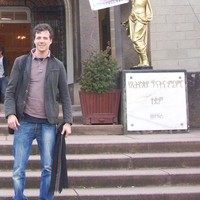- History, Anthropology, Political Science, Social Sciences, Geography, Development Studies, and 15 moreInternational Studies, Area Studies, African Studies, Africa, Ethiopian Studies, East Africa, Social science (Africa), Foreign Aid, Kenya, Piracy, Somalia, Land Grabbing, Horn of Africa, Somali Piracy, and International Relationsedit
Research Interests:
Research Interests:
Research Interests:
This article provides an account of the relationship between imperial Ethiopia and Eritrea in the realm of banking governance from the start of the federation to the last years of the imperial regime. It looks in particular at the... more
This article provides an account of the relationship between imperial Ethiopia and Eritrea in the realm of banking governance from the start of the federation to the last years of the imperial regime. It looks in particular at the relationship between the Ethiopian administrations and an Italian bank, Banco di Roma, which had its headquarters in Eritrea from 1948 to 1967 before moving to Addis Ababa. The struggle for control of the economic flows generated by the Italian bank is an index of the changes in centre–periphery linkages between Addis Ababa and the sub-regional centre of Asmara. Archival evidence highlights the multifaced nature of Ethiopian governance and the role performed by the Italian institution in providing alternative sources of diplomatic leverage and wealth accumulation to the Eritrean elite. It is argued that the extraterritorial status enjoyed by Banco di Roma until 1967 was actively tolerated by a section of the Ethiopian establishment, which resorted to an es...
Research Interests: Anthropology and Africa
Research Interests: Economic Growth and China
Research Interests:
Research Interests:
Combining a set of grey literature and primary sources, this article analyses the rise and fall of the sultanate of Awsa, northeastern Ethiopia, between 1944 and 1975. Ali Mirah exploited the typical repertoires of a frontier regime to... more
Combining a set of grey literature and primary sources, this article analyses the rise and fall of the sultanate of Awsa, northeastern Ethiopia, between 1944 and 1975. Ali Mirah exploited the typical repertoires of a frontier regime to consolidate a semi-independent Muslim chiefdom at the fringes of the Christian empire of Ethiopia. Foreign investors in commercial agriculture provided the sultanate and its counterparts within the Ethiopian state with tangible and intangible resources that shaped the quest for statecraft in the Lower Awash Valley.
Research Interests:
Il contributo analizza il processo di ristrutturazione dello Stato etiopico alla frontiera nordoccidentale tra il 1941 e il 1972, utilizzando come caso di studio un progetto di sviluppo agricolo finanziato da Banca Mondiale e Nazioni... more
Il contributo analizza il processo di ristrutturazione dello Stato etiopico alla frontiera nordoccidentale tra il 1941 e il 1972, utilizzando come caso di studio un progetto di sviluppo agricolo finanziato da Banca Mondiale e Nazioni Unite nel distretto di Setit Humera. Metodologicamente, l’articolo si avvale di fonti primarie inedite raccolte negli archivi britannici, etiopici e della Banca Mondiale, cosi come di interviste orali e letteratura grigia La ri- visitazione delle strategie di governo del bassopiano non e un processo line- are, ma il risultato delle negoziazioni tra i diversi livelli di governo de jure e de facto che esercitano prerogative di sovranita lungo il confine. La dialettica interna all’apparato statuale etiopico consente inoltre di rivedere in maniera critica il paradigma centro-periferia e cogliere le varie sfaccettature che si celano dietro la manifestazione dello Stato lungo la frontiera.
Research Interests: Art and Antropologia
Research Interests:
Research Interests:
In the first half of the twentieth century, the north-western lowlands of imperial Ethiopia were the typical interstitial frontier of the Ethiopian–Sudanese borderlands. Starting in the early 1960s, a cash crop revolution paved the way to... more
In the first half of the twentieth century, the north-western lowlands
of imperial Ethiopia were the typical interstitial frontier of the
Ethiopian–Sudanese borderlands. Starting in the early 1960s, a
cash crop revolution paved the way to the transformation of the
Mazega into a settlement frontier and the emergence of a dispute
with Sudan for demarcation of the international border. This
article explores the entanglement between the political economy
of frontier governance and border diplomacy in the contested
area. It highlights how the management of the border dispute
was deeply affected by the contradictory interests of the various
layers of government and “twilight” entities that projected
Ethiopian statecraft at the periphery.
of imperial Ethiopia were the typical interstitial frontier of the
Ethiopian–Sudanese borderlands. Starting in the early 1960s, a
cash crop revolution paved the way to the transformation of the
Mazega into a settlement frontier and the emergence of a dispute
with Sudan for demarcation of the international border. This
article explores the entanglement between the political economy
of frontier governance and border diplomacy in the contested
area. It highlights how the management of the border dispute
was deeply affected by the contradictory interests of the various
layers of government and “twilight” entities that projected
Ethiopian statecraft at the periphery.
Research Interests:
Combining a set of grey literature and primary sources, this article analyses the rise and fall of the sultanate of Awsa, northeastern Ethiopia, between 1944 and 1975. Ali Mirah exploited the typical repertoires of a frontier regime to... more
Combining a set of grey literature and primary sources, this article analyses the rise and fall of the sultanate of Awsa, northeastern Ethiopia, between 1944 and 1975. Ali Mirah exploited the typical repertoires of a frontier regime to consolidate a semi-independent Muslim chiefdom at the fringes of the Christian empire of Ethiopia. Foreign investors in commercial agriculture provided the sultanate and its counterparts within the Ethiopian state with tangible and intangible resources that shaped the quest for statecraft in the Lower Awash Valley.
